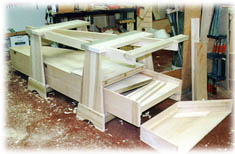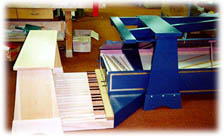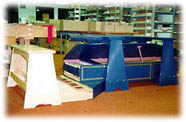We have recently filled an order for a pedal board harpsichord. Since
these are rather unique instruments, we thought some of you might find a description of
interest.
 ".
. . as elusive as the shy unicorn and possessed of the same menacing
charm . . . was how Frank Hubbard described the baroque pedal board
harpsichord in Three Centuries of Harpsichord Making (See section
on Books). Although no antique harpsichords have survived the ages with
their original pedal boards, enough 17th and 18th century references
may be found to corroborate the existence of these exotic instruments.
".
. . as elusive as the shy unicorn and possessed of the same menacing
charm . . . was how Frank Hubbard described the baroque pedal board
harpsichord in Three Centuries of Harpsichord Making (See section
on Books). Although no antique harpsichords have survived the ages with
their original pedal boards, enough 17th and 18th century references
may be found to corroborate the existence of these exotic instruments.
 Two types of pedalboard harpsichords have been
identified in workshop inventory listings of the period: (1) those with a simple pull-down
mechanism consisting of cords attached from the undersides of the manual keys to
corresponding pedals, and (2) a more complex instrument which was wholly independent of
the manual harpsichord. Apparently, both were sought after by organists as practice
instruments; however, references in Jakob Adlung, Anleitung zu der musikalischen
Gelahrheit (1758) and Johann Samuel Halle, Werkstate der heutigen Kunste(1764)
indicate that among 18th century German harpsichord makers the independent pedal
instrument was of greatest interest.
Two types of pedalboard harpsichords have been
identified in workshop inventory listings of the period: (1) those with a simple pull-down
mechanism consisting of cords attached from the undersides of the manual keys to
corresponding pedals, and (2) a more complex instrument which was wholly independent of
the manual harpsichord. Apparently, both were sought after by organists as practice
instruments; however, references in Jakob Adlung, Anleitung zu der musikalischen
Gelahrheit (1758) and Johann Samuel Halle, Werkstate der heutigen Kunste(1764)
indicate that among 18th century German harpsichord makers the independent pedal
instrument was of greatest interest.
 Our
pedal board harpsichord is of the second variety (please click
for a discussion of the origins of this design in modern times).
An independent cabinet including the lid is positioned underneath the
manual harpsichord. It stands 4" off the floor and extends a short
distance beyond the tail of the manual harpsichord. The 30-note pedalboard
is centered under C-f''' on the manual instrument. A specially fitted
stand and bench accommodate both pedal and manual instruments.
Our
pedal board harpsichord is of the second variety (please click
for a discussion of the origins of this design in modern times).
An independent cabinet including the lid is positioned underneath the
manual harpsichord. It stands 4" off the floor and extends a short
distance beyond the tail of the manual harpsichord. The 30-note pedalboard
is centered under C-f''' on the manual instrument. A specially fitted
stand and bench accommodate both pedal and manual instruments.
 The
tonal design of the Hubbard & Broekman pedal board harpsichord is
based largely on instruments by H. A. Hass. The pedalboard has a range
of C-f ' (2 1/2 octaves) and transposes one semitone providing a' at
either 415 Hz or 440 Hz. It is both straight and flat in the European
manner with naturals on 60 mm centers. The instrument is disposed 1
x 16', 1 x 8' (two registers, front- and back-plucked), 1 x 4', buff.
For tuning convenience the main instrument contains a small 31-note
manual keyboard which slides forward and disengages the pedals.
The
tonal design of the Hubbard & Broekman pedal board harpsichord is
based largely on instruments by H. A. Hass. The pedalboard has a range
of C-f ' (2 1/2 octaves) and transposes one semitone providing a' at
either 415 Hz or 440 Hz. It is both straight and flat in the European
manner with naturals on 60 mm centers. The instrument is disposed 1
x 16', 1 x 8' (two registers, front- and back-plucked), 1 x 4', buff.
For tuning convenience the main instrument contains a small 31-note
manual keyboard which slides forward and disengages the pedals.